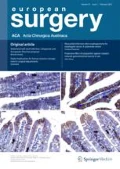Zusammenfassung
Grundlagen: Bei primärem Hyperparathyreoidismus (PHPT) werden osteolytische Veränderungen im Mund-, Kiefer- und Gesichtsbereich im Gegensatz zum übrigen Skelettsystem selten beobachtet, können aber den ersten klinischen Hinweis auf die endokrine Erkrankung darstellen. Aus diesem Grund ist die Kenntnis dieser Veränderungen, ihre differentialdiagnostische Abklärung und Therapie für den Zahnarzt und im besonderen für den Mund-, Kiefer- und Gesichtschirurgen von großer Bedeutung,
Methodik: 11 von 388 Patienten mit histologisch verifiziertem PHPT zeigten ossäre Manifestationen im Mund-, Kiefer- und Gesichtsbereich; bei 7 Patienten waren die diagnostischen und therapeutischen Details komplett. In einer retrospektiven Untersuchung wurden die Symptomatologie, die Diagnose und die Behandlung der osteolytischen Läsionen analysiert.
Ergebnisse: Bei 2 Patienten wurde der PHPT als Grunderkrankung unverzüglich erkannt. Beiden Patienten wurde eine entsprechende Therapie zuteil, nämlich eine chirurgische Behandlung des PHPT und nur nach einer Beobachtungszeit von mehreren Monaten die chirurgische Abtragung persistierender Tumoren. Bei 5 Patienten war die korrekte Diagnose des PHPT um durchschnittlich mehr als 6 Monate verzögert. Zuvor wurden die Osteolysen einer mund-, kiefer- und gesichtschirurgischen Therapie zugeführt. Zur Entfernung der Läsionen (Riesenzellgranulome) wurden 2 Existirpationen und 3 Kieferteilresektionen durchgeführt.
Schlußfolgerungen: Retrospektiv mußte diese Therapie, vor allem in Anbetracht der Kieferteilresektionen, als zu radikal erscheinen. Bei Patienten mit Riesenzellgranulomen oderähnlichen Läsionen im Mund-, Kiefer- und Gesichtsbereich muß das Vorliegen eines PHPT als Grundkrankheit durch Serumkalziumbestimmung ausgeschlossen werden.
Summary
Background: In primary hyperparathyroidism (PHPT) osteolytic lesions in the oral and maxillofacial region are rare symptoms, compared to lesions in the outer skeletal system. Nevertheless, they could be the first clinical manifestation of the metabolic disease. Therefore the knowledge of differential diagnosis and therapy is of great importance for the dentist, and especially the oral and maxillofacial surgeon.
Methods: 11 out of 388 patients with histiologically verified PHPT showed osseous manifestations in the jaws; a complete analysis of diagnostic and therapeutic details was achieved in 7 patients. In a retrospective study, the symptomatology, diagnosis and treatment of the osteolytic lesions are reviewed.
Results: In only 2 patients PHPT was immediately recognized as the primary disease. Both patients recieved adequate therapy (surgical treatment of the PHPT and after a period of several months removal of the tumor of the jaws by conservative surgery). In 5 patients, correct diagnosis of PHPT was delayed by an average time of more than 6 months. Formerly, maxillofacial surgery was carried out in all cases. To remove the tumors (giant cell granulomas), 2 exstirpations and 3 partial resections of the jaws were performed.
Conclusions: Retrospectively, surgery was too radical in these patients. We request PHPT to be excluded by determining serum calcium in all patients with giant cell granulomas or similar lesions in the jaws.
Literatur
Akerström G, Bergström R, Grimelius L, Johansson H, Ljunghall S, Lundström B, Palmer M, Rastad J, Rudberg C: Relation between changes in clinical and histopathological features of primary hyperparathyroidism. World J Surg 1986;10:696–702.
Bilezikian JP: Etiologies and therapy of hypercalcaemia. Endocrinol Metabol Clin N. Am 1989;18:398–414.
Desai P, Steiner GC: Ultrastructure of brown tumor of hyperparathyroidism. Ultrastruct Pathol 1990;14:505–511.
Dotzenrath C, Goretzki PE, Röher HD: West Germany, a still underdeveloped country in diagnosis and early treatment of HPT. World J Surg 1990;14:660–663.
Fritsch A, Geyer G: Hyperparathyreoidismus — Diagnostik und Therapie der Nebenschilddrüsenüberfunktion. Wien-München-Baltimore, Urban & Schwarzenberg, 1982.
Hesch RD: Die konservative Therapie des extraadrenalen Hyperparathyreoidismus, in Beyer J, Krause K (eds): Therapie des Hyperparathyreoidismus. Stuttgart-New York, Schattauer, 1981, pp 51–69.
Hoffmeister B, Moubayed P: Histogenese und Diagnostik zentraler und peripherer Riesenzellgranulome. Fortschr Kiefer-Gesichtschir 1986;31:12–16.
Huvos AG: Bone Tumors (Diagnosis, Treatment and Prognosis). Philadelphia-London-Toronto-Montreal-Sydney-Tokyo, Saunders, 1991.
Jaffe HL: Giant cell reparative granuloma, traumatic bone cyst and fibrous dysplasia of the jaw bones. Oral Surg 1953;6:159–175.
Mallette LE: Review: Primary hyperparathyroidism, an update: Incidence, etiology, diagnosts and treatment. Am J Med Sci 1987:239–249.
Niederle B, Roka R, Fritsch A: Long term results after surgical treatment of primary hyperparathyroidism. Progr Surg 1986;18:146–164.
Niederle B, Roka R, Woloszczuk W, Klaushofer K, Kovarik B, Schernthaner G: Successful parathyroidectomy in primary hyperparathyroidism. A clinical follow-up study of 212 consecutive patients. Surgery 1987;102:903–909.
Niederle B, Stamm L, Längle F, Schubert E, Woloszczuk W, Prager R: Primary Hyperparathyroidism in Austria — results of an 8-year retrospective study. World J Surg 1992;16:777–783.
Plenk H, Eschberger J, Delling G: Methoden und klinische Bedeutung der Knochenbiopsie, in Fritsch A, Geyer G (eds): Hyperparathyreoidismus — Diagnostik und Therapie der Nebenschilddrüsenüberfunktion. Wien-München-Baltimore, Urban & Schwarzenberg, 1982, pp 49–62.
Prein J, Remagen W, Spiessl B, Uehlinger E: Atlas der Tumoren des Gesichtsschädels. Zentrales Referenzregister des DÖSAK. Berlin, Springer, 1985.
Rosenberg EH, Guralnick WC: Hyperparathyroidism. A review of 220 proved cases, with special emphasis on findings in the jaws. Oral Suppl 1962;15:84–94.
Schroeder HE: Pathobiologie oraler Strukturen. Basel-Munich-Paris-London-New York-Tokyo-Sydney, Karger, 1983, 152–154.
Silverman S jr, Ware WH, Gillooly C jr: Dental aspects of hyperparathyroidism. Oral Surg Oral Med Oral Pathol 1968;26:184–189.
Soskolne WA: Peripheral giant cell granulomas: an ultrastructural study of three lesions. J Oral Pathol 1972;1:133–143.
Sturrock BD, Marks RB, Gross BD, Carr RF: Giant cell tumor of the mandible. J Oral Maxillofac Surg 1984;42:262–267.
Wepner F, Fries R, Engleder R: Reparative riesenzellhaltige Granulome als Manifestation des primären Hyperparathyreoidismus im Kieferbereich. Quintessenz 1987;38:1621–1628.
Wunderer S: Die Symptomatik des primären Hyperparathyreoidismus im Mundhöhlen-Kieferbereich. Dtsch Zahn-Mund-Kieferheilk 1970;55:127–133.
Wunderer S, Watzke I: Manifestationen des primären Hyperparathyreoidismus im Kiefer-Gesichtsbereich und ihre Behandlung. Fortschr Kiefer-Gesichtschir 1986;31:133–135.
Author information
Authors and Affiliations
Rights and permissions
About this article
Cite this article
Millesi, W., Niederle, B., Roka, R. et al. Osteolysen im Kieferbereich als erster Hinweis auf einen primären Hyperparathyreoidismus. Acta Chir Austriaca 26, 410–414 (1994). https://doi.org/10.1007/BF02620046
Issue Date:
DOI: https://doi.org/10.1007/BF02620046

